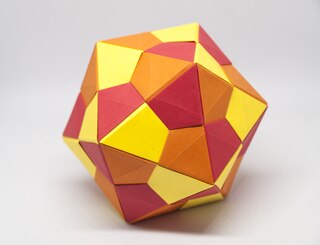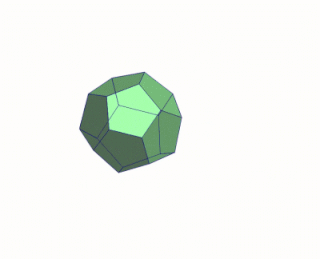
In geometry, an Archimedean solid is one of 13 convex polyhedra whose faces are regular polygons and whose vertices are all symmetric to each other. They were first enumerated by Archimedes. They belong to the class of convex uniform polyhedra, the convex polyhedra with regular faces and symmetric vertices, which is divided into the Archimedean solids, the five Platonic solids, and the two infinite families of prisms and antiprisms. The pseudorhombicuboctahedron is an extra polyhedron with regular faces and congruent vertices, but it is not generally counted as an Archimedean solid because it is not vertex-transitive. An even larger class than the convex uniform polyhedra is the Johnson solids, whose regular polygonal faces do not need to meet in identical vertices.

In geometry, the regular icosahedron is a convex polyhedron that can be constructed from pentagonal antiprism by attaching two pentagonal pyramids with regular faces to each of its pentagonal faces, or by putting points onto the cube. The resulting polyhedron has 20 equilateral triangles as its faces, 30 edges, and 12 vertices. It is an example of a Platonic solid and of a deltahedron. The icosahedral graph represents the skeleton of a regular icosahedron.

In geometry, a polyhedron is a three-dimensional figure with flat polygonal faces, straight edges and sharp corners or vertices.
In geometry, a Platonic solid is a convex, regular polyhedron in three-dimensional Euclidean space. Being a regular polyhedron means that the faces are congruent regular polygons, and the same number of faces meet at each vertex. There are only five such polyhedra:

Origami is the Japanese art of paper folding. In modern usage, the word "origami" is often used as an inclusive term for all folding practices, regardless of their culture of origin. The goal is to transform a flat square sheet of paper into a finished sculpture through folding and sculpting techniques. Modern origami practitioners generally discourage the use of cuts, glue, or markings on the paper. Origami folders often use the Japanese word kirigami to refer to designs which use cuts.

Modular origami or unit origami is a multi-stage paper folding technique in which several, or sometimes many, sheets of paper are first folded into individual modules or units and then assembled into an integrated flat shape or three-dimensional structure, usually by inserting flaps into pockets created by the folding process. These insertions create tension or friction that holds the model together. Some assemblies can be somewhat unstable because adhesives or string are not used.

In geometry, the pentagonal bipyramid is a polyhedron with 10 triangular faces. It is constructed by attaching two pentagonal pyramids to each of their bases. If the triangular faces are equilateral, the pentagonal bipyramid is an example of deltahedra, composite polyhedron, and Johnson solid.

In geometry, the snub disphenoid is a convex polyhedron with 12 equilateral triangles as its faces. It is an example of deltahedron and Johnson solid. It can be constructed in different approaches. This shape also has alternative names called Siamese dodecahedron, triangular dodecahedron, trigonal dodecahedron, or dodecadeltahedron.

In geometry, a net of a polyhedron is an arrangement of non-overlapping edge-joined polygons in the plane which can be folded to become the faces of the polyhedron. Polyhedral nets are a useful aid to the study of polyhedra and solid geometry in general, as they allow for physical models of polyhedra to be constructed from material such as thin cardboard.

A polyhedron model is a physical construction of a polyhedron, constructed from cardboard, plastic board, wood board or other panel material, or, less commonly, solid material.

The Sonobe module is one of the many units used to build modular origami. The popularity of Sonobe modular origami models derives from the simplicity of folding the modules, the sturdy and easy assembly, and the flexibility of the system.
Cauchy's theorem is a theorem in geometry, named after Augustin Cauchy. It states that convex polytopes in three dimensions with congruent corresponding faces must be congruent to each other. That is, any polyhedral net formed by unfolding the faces of the polyhedron onto a flat surface, together with gluing instructions describing which faces should be connected to each other, uniquely determines the shape of the original polyhedron. For instance, if six squares are connected in the pattern of a cube, then they must form a cube: there is no convex polyhedron with six square faces connected in the same way that does not have the same shape.

Rigid origami is a branch of origami which is concerned with folding structures using flat rigid sheets joined by hinges. That is, unlike in traditional origami, the panels of the paper cannot be bent during the folding process; they must remain flat at all times, and the paper only folded along its hinges. A rigid origami model would still be foldable if it was made from glass sheets with hinges in place of its crease lines.
The Alexandrov uniqueness theorem is a rigidity theorem in mathematics, describing three-dimensional convex polyhedra in terms of the distances between points on their surfaces. It implies that convex polyhedra with distinct shapes from each other also have distinct metric spaces of surface distances, and it characterizes the metric spaces that come from the surface distances on polyhedra. It is named after Soviet mathematician Aleksandr Danilovich Aleksandrov, who published it in the 1940s.
Geometric Folding Algorithms: Linkages, Origami, Polyhedra is a monograph on the mathematics and computational geometry of mechanical linkages, paper folding, and polyhedral nets, by Erik Demaine and Joseph O'Rourke. It was published in 2007 by Cambridge University Press (ISBN 978-0-521-85757-4). A Japanese-language translation by Ryuhei Uehara was published in 2009 by the Modern Science Company (ISBN 978-4-7649-0377-7).
Descartes on Polyhedra: A Study of the "De solidorum elementis" is a book in the history of mathematics, concerning the work of René Descartes on polyhedra. Central to the book is the disputed priority for Euler's polyhedral formula between Leonhard Euler, who published an explicit version of the formula, and Descartes, whose De solidorum elementis includes a result from which the formula is easily derived.
Adventures Among the Toroids: A study of orientable polyhedra with regular faces is a book on toroidal polyhedra that have regular polygons as their faces. It was written, hand-lettered, and illustrated by mathematician Bonnie Stewart, and self-published under the imprint "Number One Tall Search Book" in 1970. Stewart put out a second edition, again hand-lettered and self-published, in 1980. Although out of print, the Basic Library List Committee of the Mathematical Association of America has recommended its inclusion in undergraduate mathematics libraries.
Convex Polyhedra is a book on the mathematics of convex polyhedra, written by Soviet mathematician Aleksandr Danilovich Aleksandrov, and originally published in Russian in 1950, under the title Выпуклые многогранники. It was translated into German by Wilhelm Süss as Konvexe Polyeder in 1958. An updated edition, translated into English by Nurlan S. Dairbekov, Semën Samsonovich Kutateladze and Alexei B. Sossinsky, with added material by Victor Zalgaller, L. A. Shor, and Yu. A. Volkov, was published as Convex Polyhedra by Springer-Verlag in 2005.

In the geometry of convex polyhedra, blooming or continuous blooming is a continuous three-dimensional motion of the surface of the polyhedron, cut to form a polyhedral net, from the polyhedron into a flat and non-self-overlapping placement of the net in a plane. As in rigid origami, the polygons of the net must remain individually flat throughout the motion, and are not allowed to intersect or cross through each other. A blooming, reversed to go from the flat net to a polyhedron, can be thought of intuitively as a way to fold the polyhedron from a paper net without bending the paper except at its designated creases.












